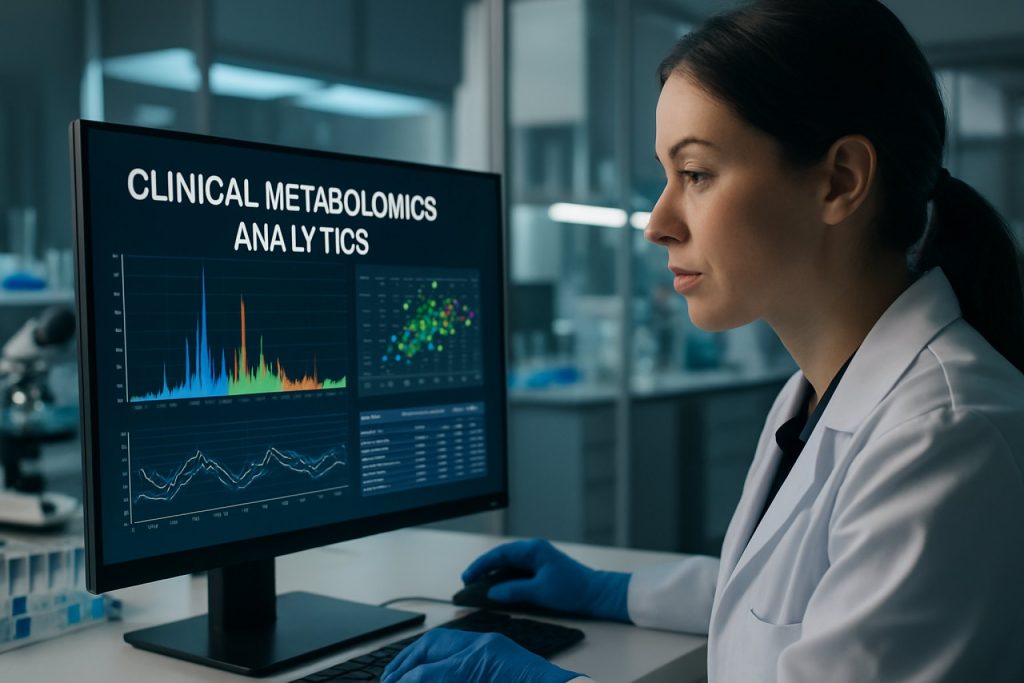
Clinical Metabolomics Analytics Market Report 2025: Trends, Technologies, and Strategic Insights for the Next 5 Years. Explore Market Drivers, Competitive Dynamics, and Regional Opportunities Shaping the Future.
- Executive Summary & Market Overview
- Key Technology Trends in Clinical Metabolomics Analytics
- Competitive Landscape and Leading Players
- Market Growth Forecasts (2025–2030): CAGR, Revenue, and Volume Analysis
- Regional Analysis: North America, Europe, Asia-Pacific, and Rest of World
- Challenges and Opportunities in Clinical Metabolomics Analytics
- Future Outlook: Innovation, Regulation, and Market Expansion
- Sources & References
Executive Summary & Market Overview
Clinical metabolomics analytics refers to the comprehensive analysis of metabolites within biological samples to support disease diagnosis, prognosis, and therapeutic monitoring. As of 2025, the global clinical metabolomics analytics market is experiencing robust growth, driven by advances in high-throughput technologies, increasing prevalence of chronic diseases, and a growing emphasis on precision medicine. Metabolomics, as a key component of systems biology, enables clinicians and researchers to gain deeper insights into metabolic alterations associated with various pathologies, including cancer, cardiovascular diseases, and metabolic disorders.
According to recent market research, the global clinical metabolomics market is projected to reach USD 4.5 billion by 2025, expanding at a compound annual growth rate (CAGR) of approximately 12% from 2020 to 2025. This growth is underpinned by the rising adoption of mass spectrometry (MS) and nuclear magnetic resonance (NMR) spectroscopy platforms, which offer high sensitivity and specificity for metabolite profiling. The integration of artificial intelligence (AI) and machine learning (ML) algorithms further enhances data interpretation, enabling more accurate biomarker discovery and patient stratification Grand View Research.
North America currently dominates the clinical metabolomics analytics market, attributed to significant investments in healthcare infrastructure, strong presence of leading biopharmaceutical companies, and supportive regulatory frameworks. Europe follows closely, with increasing research funding and collaborative initiatives between academic institutions and industry players. The Asia-Pacific region is anticipated to witness the fastest growth, fueled by expanding healthcare access, rising awareness of personalized medicine, and government initiatives to promote biomedical research MarketsandMarkets.
- Key Drivers: Technological advancements in analytical platforms, growing demand for early disease detection, and the shift towards personalized healthcare.
- Challenges: High costs of instrumentation, complexity of data analysis, and the need for standardized protocols.
- Opportunities: Expansion into untapped emerging markets, development of novel biomarker panels, and integration with multi-omics approaches.
In summary, the clinical metabolomics analytics market in 2025 is characterized by rapid technological innovation, expanding clinical applications, and increasing collaboration across the healthcare ecosystem. These trends are expected to further accelerate the adoption of metabolomics analytics in clinical practice, ultimately improving patient outcomes and advancing the field of precision medicine.
Key Technology Trends in Clinical Metabolomics Analytics
Clinical metabolomics analytics is rapidly evolving, driven by technological advancements that are enhancing the precision, throughput, and clinical utility of metabolomic data. In 2025, several key technology trends are shaping the landscape of clinical metabolomics analytics, enabling deeper insights into disease mechanisms, biomarker discovery, and personalized medicine.
- Integration of Multi-Omics Data: The convergence of metabolomics with genomics, proteomics, and transcriptomics is becoming increasingly prevalent. Advanced bioinformatics platforms now allow for the seamless integration and analysis of multi-omics datasets, providing a holistic view of patient health and disease progression. This trend is supported by the development of robust data integration tools and AI-driven analytics, as highlighted by Illumina and Thermo Fisher Scientific.
- Advancements in Mass Spectrometry (MS) and Nuclear Magnetic Resonance (NMR): High-resolution MS and NMR technologies are at the forefront of metabolomics analytics. Recent innovations have improved sensitivity, speed, and reproducibility, enabling the detection of low-abundance metabolites in complex clinical samples. Companies such as Bruker and Agilent Technologies are leading the way with next-generation instruments tailored for clinical applications.
- Artificial Intelligence and Machine Learning: AI and ML algorithms are increasingly being used to process and interpret large-scale metabolomics datasets. These technologies facilitate pattern recognition, biomarker identification, and predictive modeling, accelerating the translation of metabolomic findings into clinical practice. IBM and Siemens Healthineers are notable for their investments in AI-driven healthcare analytics.
- Cloud-Based Analytics and Data Sharing: The adoption of cloud computing platforms is streamlining data storage, sharing, and collaborative analysis across institutions. This trend is crucial for multi-center clinical studies and the development of large, diverse metabolomics databases, as seen in initiatives supported by Microsoft and Google Cloud.
- Point-of-Care and Miniaturized Devices: The emergence of portable and user-friendly metabolomics devices is enabling near-patient testing and real-time analytics. These innovations are expanding the reach of metabolomics into routine clinical workflows and remote settings, as demonstrated by developments from Abbott and Zoetis.
Collectively, these technology trends are propelling clinical metabolomics analytics toward greater clinical adoption, improved patient outcomes, and the realization of precision medicine in 2025 and beyond.
Competitive Landscape and Leading Players
The competitive landscape of the clinical metabolomics analytics market in 2025 is characterized by a dynamic mix of established life sciences companies, specialized analytics providers, and emerging startups. The sector is witnessing intensified competition driven by rapid technological advancements, increasing clinical adoption, and the growing integration of artificial intelligence (AI) and machine learning (ML) for data interpretation.
Key players dominating the market include Agilent Technologies, Bruker Corporation, and Thermo Fisher Scientific. These companies leverage their extensive portfolios in mass spectrometry, chromatography, and bioinformatics to offer comprehensive metabolomics solutions tailored for clinical research and diagnostics. Their global reach, robust R&D investments, and strategic collaborations with academic and healthcare institutions have solidified their leadership positions.
In addition to these giants, specialized firms such as Metabolon and Biocrates Life Sciences are recognized for their proprietary metabolomics platforms and targeted assay kits. These companies focus on high-throughput, clinically validated workflows that enable biomarker discovery, disease stratification, and personalized medicine applications. Their expertise in data analytics and interpretation is a key differentiator, particularly as clinical metabolomics moves toward routine use in precision diagnostics.
The market is also witnessing the entry of innovative startups and software vendors, such as OmicSoft (a QIAGEN company) and Phenomenome Discoveries, which are developing cloud-based analytics platforms and AI-driven tools for metabolomics data management and visualization. These entrants are intensifying competition by offering scalable, user-friendly solutions that address the growing demand for actionable clinical insights from complex metabolomic datasets.
Strategic partnerships, mergers, and acquisitions are shaping the competitive dynamics. For example, Thermo Fisher Scientific has expanded its clinical metabolomics capabilities through acquisitions and collaborations with digital health companies, while Bruker Corporation continues to invest in next-generation mass spectrometry platforms and software integration.
Overall, the 2025 clinical metabolomics analytics market is marked by consolidation among leading players, a surge in innovation from niche providers, and a strong emphasis on data-driven clinical applications. This evolving landscape is expected to accelerate the translation of metabolomics research into routine clinical practice, further intensifying competition and driving market growth.
Market Growth Forecasts (2025–2030): CAGR, Revenue, and Volume Analysis
The clinical metabolomics analytics market is poised for robust growth between 2025 and 2030, driven by technological advancements, expanding clinical applications, and increasing investments in precision medicine. According to projections by MarketsandMarkets, the global metabolomics market—which includes clinical analytics—is expected to register a compound annual growth rate (CAGR) of approximately 13–15% during this period. This growth is underpinned by the rising adoption of metabolomics in disease biomarker discovery, drug development, and personalized healthcare strategies.
Revenue forecasts indicate that the clinical segment will contribute significantly to the overall market expansion. By 2025, the global clinical metabolomics analytics market is estimated to reach a valuation of around USD 1.5 billion, with projections suggesting it could surpass USD 3.0 billion by 2030. This doubling in market size reflects both the increasing volume of clinical studies utilizing metabolomics and the integration of advanced analytical platforms, such as mass spectrometry and nuclear magnetic resonance (NMR), into routine clinical workflows (Grand View Research).
Volume analysis further underscores the market’s momentum. The number of clinical metabolomics tests performed annually is expected to grow at a CAGR of over 14% from 2025 to 2030, as reported by Fortune Business Insights. This surge is attributed to the expanding use of metabolomics in oncology, neurology, and cardiology, as well as the increasing prevalence of chronic diseases that require advanced diagnostic and prognostic tools. Additionally, the proliferation of high-throughput analytical platforms and the decreasing cost per test are making metabolomics analytics more accessible to clinical laboratories worldwide.
- CAGR (2025–2030): 13–15%
- Revenue (2025): ~USD 1.5 billion
- Revenue (2030): >USD 3.0 billion
- Test Volume Growth (2025–2030): >14% CAGR
In summary, the clinical metabolomics analytics market is set for accelerated growth through 2030, fueled by technological innovation, expanding clinical utility, and a global shift toward precision medicine. Stakeholders can expect increasing revenue opportunities and a rapidly growing volume of clinical applications in the coming years.
Regional Analysis: North America, Europe, Asia-Pacific, and Rest of World
The global clinical metabolomics analytics market is witnessing robust growth, with regional dynamics shaped by healthcare infrastructure, research investments, and regulatory environments. In 2025, North America, Europe, Asia-Pacific, and the Rest of the World (RoW) each present distinct opportunities and challenges for market participants.
- North America: North America remains the largest market for clinical metabolomics analytics, driven by advanced healthcare systems, significant R&D funding, and the presence of leading biopharmaceutical companies. The United States, in particular, benefits from strong support for precision medicine initiatives and a high adoption rate of omics technologies. The region’s growth is further propelled by collaborations between academic institutions and industry, as well as favorable reimbursement policies for diagnostic innovations. According to Grand View Research, North America accounted for over 40% of the global market share in 2024, a trend expected to continue into 2025.
- Europe: Europe is characterized by a robust regulatory framework and substantial public funding for biomedical research. Countries such as Germany, the UK, and France are at the forefront, leveraging strong academic networks and government-backed initiatives to advance metabolomics in clinical settings. The European Union’s Horizon Europe program continues to fuel innovation, while the region’s focus on personalized medicine and chronic disease management supports market expansion. MarketsandMarkets projects steady growth in Europe, with increasing adoption in both research and clinical diagnostics.
- Asia-Pacific: The Asia-Pacific region is emerging as a high-growth market, underpinned by expanding healthcare infrastructure, rising investments in life sciences, and a growing patient population. Countries like China, Japan, and South Korea are investing heavily in genomics and metabolomics research, supported by government initiatives and international collaborations. The region’s market is expected to register the fastest CAGR through 2025, as reported by Fortune Business Insights, driven by increasing awareness of precision medicine and the need for advanced diagnostic tools.
- Rest of World (RoW): In regions such as Latin America, the Middle East, and Africa, the clinical metabolomics analytics market is at a nascent stage. Growth is constrained by limited infrastructure and lower R&D spending, but rising healthcare investments and international partnerships are gradually improving market prospects. Local governments are beginning to recognize the value of metabolomics in disease surveillance and public health, which could spur future growth.
Challenges and Opportunities in Clinical Metabolomics Analytics
Clinical metabolomics analytics, the comprehensive study of small-molecule metabolites in clinical samples, is rapidly transforming precision medicine by enabling early disease detection, patient stratification, and therapy monitoring. However, as the field matures in 2025, it faces a complex landscape of challenges and opportunities that will shape its trajectory in healthcare.
Challenges
- Data Complexity and Standardization: The vast heterogeneity of metabolomic data, stemming from diverse sample types, analytical platforms, and protocols, complicates data integration and reproducibility. The lack of universally accepted standards for sample preparation, data acquisition, and reporting remains a significant barrier to cross-study comparisons and clinical adoption (Nature Medicine).
- Regulatory Hurdles: Translating metabolomics discoveries into clinically approved diagnostics or therapeutics requires rigorous validation and compliance with regulatory frameworks. The evolving nature of omics-based biomarkers poses challenges for regulatory agencies in establishing clear guidelines for clinical use (U.S. Food and Drug Administration).
- Bioinformatics and Interpretation: The interpretation of high-dimensional metabolomics data demands advanced bioinformatics tools and expertise. There is a shortage of user-friendly, clinically validated software capable of translating complex metabolic signatures into actionable clinical insights (Frontiers in Medicine).
- Cost and Accessibility: High costs associated with state-of-the-art analytical platforms (e.g., mass spectrometry, NMR) and skilled personnel limit widespread adoption, particularly in resource-constrained settings (MarketsandMarkets).
Opportunities
- Integration with Multi-Omics and AI: Combining metabolomics with genomics, proteomics, and advanced AI-driven analytics is unlocking deeper biological insights and more robust clinical biomarkers, accelerating the path to personalized medicine (IBM).
- Expansion of Clinical Applications: Metabolomics is increasingly being applied to oncology, neurology, cardiology, and infectious diseases, with several clinical trials underway to validate metabolite-based diagnostics and prognostics (ClinicalTrials.gov).
- Emergence of Point-of-Care Solutions: Advances in miniaturized, rapid metabolomics platforms are paving the way for point-of-care testing, which could democratize access and enable real-time clinical decision-making (Thermo Fisher Scientific).
In summary, while clinical metabolomics analytics faces significant technical, regulatory, and economic challenges in 2025, ongoing innovation and cross-disciplinary collaboration are creating substantial opportunities for its integration into mainstream clinical practice.
Future Outlook: Innovation, Regulation, and Market Expansion
The future outlook for clinical metabolomics analytics in 2025 is shaped by a dynamic interplay of technological innovation, evolving regulatory frameworks, and expanding market opportunities. As precision medicine gains traction, the demand for advanced metabolomics analytics is expected to surge, driven by the need for more accurate disease diagnostics, personalized treatment strategies, and robust biomarker discovery.
Innovation remains at the forefront, with next-generation mass spectrometry, nuclear magnetic resonance (NMR) technologies, and artificial intelligence (AI)-driven data analytics transforming the landscape. Companies are investing heavily in automation and high-throughput platforms to enhance sensitivity, reproducibility, and scalability of metabolomic profiling. For instance, the integration of machine learning algorithms is enabling the extraction of clinically relevant insights from complex metabolomic datasets, accelerating the translation of research findings into actionable clinical applications. According to Thermo Fisher Scientific, advancements in sample preparation and data processing are reducing turnaround times and improving the reliability of clinical metabolomics workflows.
Regulatory considerations are also evolving, as agencies such as the U.S. Food and Drug Administration (FDA) and the European Medicines Agency (EMA) refine guidelines for the validation and clinical adoption of metabolomics-based diagnostics. In 2025, stakeholders anticipate more harmonized standards for data quality, reproducibility, and patient privacy, which are critical for the widespread clinical integration of metabolomics analytics. The push for regulatory clarity is expected to foster greater confidence among healthcare providers and payers, further accelerating market adoption.
- Market Expansion: The global clinical metabolomics analytics market is projected to experience robust growth, with estimates from MarketsandMarkets forecasting a CAGR exceeding 12% through 2025. Expansion is particularly notable in oncology, neurology, and metabolic disease segments, as well as in emerging markets across Asia-Pacific and Latin America.
- Collaborative Ecosystems: Strategic partnerships between academic institutions, healthcare providers, and industry players are fostering innovation and facilitating the development of clinically validated metabolomic assays. Initiatives such as the National Institutes of Health (NIH) Metabolomics Program are catalyzing translational research and standardization efforts.
In summary, 2025 is poised to be a pivotal year for clinical metabolomics analytics, marked by technological breakthroughs, regulatory maturation, and significant market expansion, collectively advancing the field toward routine clinical implementation.
Sources & References
- Grand View Research
- MarketsandMarkets
- Illumina
- Thermo Fisher Scientific
- Bruker
- IBM
- Siemens Healthineers
- Microsoft
- Google Cloud
- Zoetis
- Metabolon
- Biocrates Life Sciences
- Fortune Business Insights
- Nature Medicine
- Frontiers in Medicine
- ClinicalTrials.gov
- European Medicines Agency (EMA)
- National Institutes of Health (NIH)



